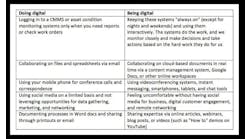Rebuilding business continuity in tumultuous times
Continuity. It’s something that has been ripped away from many of us in the past 12 months and something that is slowly rebuilding as we recover from the pandemic. But how do manufacturers establish continuity in a business landscape that continues to be unsteady?
It ain’t easy. Just ask Jerome Soltani, SVP of US Services at Schneider Electric, who recently managed an initiative to implement new digital asset-management technology to maintain some semblance of business continuity. When COVID-19 hit, Soltani and his team realized Schneider Electric needed to fast-track its digitalization plans to continue to provide the same level of service—even amidst a global crisis.
Here, we dive into that process…
Smart Industry: How is the role of digital asset management changing the notion of business continuity during these trying times?
Jerome: The pandemic has definitely accelerated the need for digitization and changed the conversation from ‘why’ to ‘how,’ as many organizations have increased their prioritization of their own digitization path. The challenges of the pandemic have added further strain to outdated practices, such as paper-based reporting, siloed systems, etc. At the same time, the challenges that were facing businesses over the past few years—a lack of CAPEX funding, skill shortage, aging equipment and an aging workforce—have not gone away.
At Schneider Electric Services, fortunately, we were better prepared for the pandemic due to our move to digitization of our services business over the past few years. One of our technology partners for field-service management, ServiceMax, helped make this transformative journey possible, allowing us to more efficiently manage our diverse and global workforce with improved ability for safely and efficiently delivering services. Due to our digital, centralized processes and service operations, our service teams and technicians were able to continue to serve customers despite the challenges of the pandemic.
Some of our customers who are further along on their path to digitization have also noted significantly reduced disruptions to their business overall. Benefits such as increase in meantime between unplanned outages, increase in meantime between standard failure, reduction in meantime and average cost-to-repair standard failures, which help them with business continuity and resiliency.
Digital asset management is enabling efficiencies in the use of resources through a shift from reactive to predictive and even condition-based maintenance; this helps improve the total cost of ownership of their business-critical assets. The ability to incorporate failure prediction through analytics and 24/7 remote-monitoring capabilities not only enhances personnel and infrastructure safety, but is allowing business to better plan, prepare and react in order to maximize uptime, saving time and money as well as reducing some of the strain of those other challenges facing the business.
Smart Industry: What is involved with your concept of ‘building a faster path to full digitalization’?
Jerome: Recent events have caused a faster path to digitization for many, but they have still needed to clear hurdles to move the process forward. Alignment of internal stakeholders is critical for success, as digitization can represent a cultural shift that will require buy-in from all levels. It may also require business processes and strategies to be updated, as well as updating equipment.
I suggest outlining your business needs, then taking a step approach to implement incremental improvements toward efficiency gains. Once the benefit has been proven from one change, it can be much easier to drive further improvements. Working with a trusted partner that is experienced in the process also helps to reduce the learning curve and watching for potential challenges (such as cybersecurity and cost overruns) that can negatively impact a project.
In our case, the service data we collect in ServiceMax reaches into almost every facet of our organization. Our transformation granted us valuable insights into the service department, as well as R&D, operations, sales, finance, and marketing teams to enable management to drive toward enhanced customer experience.
Smart Industry: How is servitization changing? Do customers expect more in this digital era?
Jerome: We have seen servitization gain momentum based on new technologies and the process efficiencies that they have driven. Traditional services customers are seeing the value of going from reactive to outcome-based services. In many cases, customers are benefiting from these efficiencies by getting enhanced service for a reduced cost.
For example, through the aging of a critical industrial or facility asset (transformer, motor, drive, circuit-breaker, UPS, etc.), we can track and monitor the condition of that asset through thermal and environmental sensors and predictive analytics based on our expertise as the OEM. This allows the customer to receive alarms and notifications when equipment performance goes outside of an expected operating range, thereby monitoring the risk of potential unwanted wear-and-tear or a failure, which may impact safety or operational continuity. Our experts then remotely make a recommendation to the facility or plant operations or maintenance management. This approach ensures the customer can proactively fix a problem before it causes failure and enables operational and cost efficiencies.
To be successful, service providers need to understand their customers’ business and have expertise in the right domains to help augment those customers’ in-house capabilities and more effectively serve their needs. Companies must also have an understanding of the concerns and the challenges that customers face and put measures in place to mitigate them. Response-time and cybersecurity are critical; customers need service providers to be more agile than ever before, anticipating customers’ needs before they arise. ServiceMax technology supports equipment asset and workforce data management/tracking, which enables us to proactively and more efficiently support our customers.
From a remote-management standpoint, the architecture, platform and services must facilitate secure remote access, centralized monitoring capabilities and 24/7 cybersecure access to experts to ensure business continuity.
Smart Industry: What most excites you about new approaches with asset management/business continuity as we emerge from this pandemic?
Jerome: The pandemic has fundamentally changed the nature of the relationship and the role of the service provider—from an afterthought to a critical business partner unlocking the value of IoT investments.
Asset management has opened new ways of empowering people and businesses, from stronger collaboration between internal teams to greater insights and efficiencies within operations regarding uptime, safety and costs; this, ultimately, drives better outcomes for our customers.
In short, digital transformation is enabling unprecedented growth and profitability, driving those on the fence to prioritize digitization and those with experience to gain momentum in their digitization journeys.


